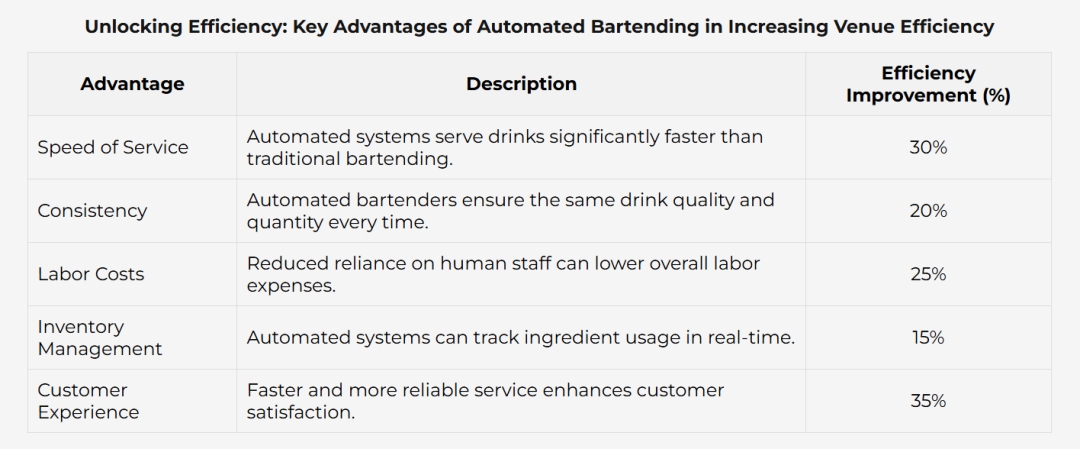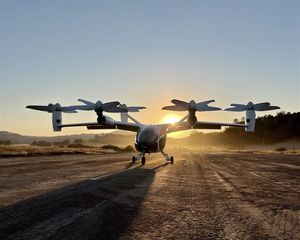In today's fast-paced hospitality landscape, venues are constantly seeking innovative ways to enhance efficiency and improve customer experience. Enter the AI Robot Bartender, a revolutionary solution that addresses numerous challenges faced by traditional bartending. From long wait times and inconsistent drink quality to high labor costs and staffing shortages, the integration of AI technology in bartending not only streamlines operations but also elevates the service standard significantly. This game-changing advancement allows venues to serve more customers with precision and speed, while also freeing up human bartenders to engage in more personalized interactions. As we delve deeper into the transformative impact of automated bartending, it becomes clear that adopting an AI Robot Bartender is not merely a trend, but a strategic move toward operational excellence in the competitive world of hospitality.
The Rise of Automated Bartending: Transforming Venue Operations Globally
The rise of automated bartending is reshaping venue operations across the globe, introducing a new era of efficiency and innovation. With the integration of advanced technologies, venues can now serve a broader array of beverages with precision and speed. Automated bartenders streamline the drink-making process, reducing wait times and allowing staff to focus on customer engagement and experience. This transformation is particularly beneficial in high-demand environments such as bars, clubs, and large events, where swift service can make all the difference in customer satisfaction.
Furthermore, automated bartending systems not only enhance operational efficiency but also reduce labor costs and the potential for human error. These systems can be programmed to mix drinks with exact measurements, ensuring consistency in taste and presentation every time. As more venues adopt this technology, they can leverage data analytics to better understand customer preferences and manage inventory smartly. This blend of automation and data-driven insights is revolutionizing how venues function, allowing them to adapt quickly to changing consumer demands while delivering an exceptional experience.
Key Advantages of Automated Bartending in Increasing Venue Efficiency
Automated bartending systems are transforming the hospitality industry, unlocking unparalleled efficiency for venues of all sizes. With the global market for automated bartending expected to grow significantly, reaching $268 million in 2025 and $2.1425 billion by 2033, it's clear that this innovation is not just a fleeting trend but a substantial advancement for bar operations. These systems streamline drink preparation, allowing venue staff to serve customers faster and with consistent quality, ultimately enhancing customer satisfaction.
One of the key advantages of automated bartending is the reduction of labor costs. With fewer bartenders needed during peak hours, venues can allocate their resources more effectively, minimizing wait times and maximizing service efficiency. Additionally, automated systems ensure precise measurements, reducing waste and promoting better inventory management. By embracing this technology, venues are not only increasing their productivity but also improving their bottom line, making automated bartending a pivotal component in the future of hospitality.

Market Trends: The Growing Demand for Automated Solutions in the Beverage Industry
The beverage industry is witnessing a remarkable shift towards automation, driven by the increasing demand for efficiency and precision in service delivery. The automated bartending market is a prime example of this trend, where establishments are turning to technology to streamline operations and enhance customer experiences. According to projections, the global mechatronic cylinder market is set to reach $635.2 million by 2025, highlighting the rapid adoption of automated solutions across various sectors.
Furthermore, the programmable logic controller (PLC) automation market is anticipated to grow significantly, reaching $15.5 billion by 2032 with a compound annual growth rate (CAGR) of 4.27%. This surge underscores the industry's push towards sophisticated automated systems that can manage complex tasks more effectively. Notably, the warehouse robotics market is expected to expand from $6.51 billion in 2025 to $17.98 billion by 2032, indicating a broader trend where automation is not only enhancing operational efficiency but also meeting the rising consumer expectation for speed and quality in service delivery. As venues adopt these technologies, the potential for improved productivity and customer satisfaction becomes increasingly evident.
Impact of Automation on Labor Costs and Customer Satisfaction in Bars
Automated bartending systems are revolutionizing the bar industry by addressing two critical factors: labor costs and customer satisfaction. With the introduction of technology-driven bartending solutions, venues can significantly reduce the number of staff required during peak hours. This not only cuts down on labor costs but also minimizes human errors in drink preparation, ensuring that customers receive consistent quality and timely service. Venues can redirect their financial resources towards enhancing the ambiance or investing in marketing, allowing for a more competitive edge in an ever-changing market.
Customer satisfaction is deeply intertwined with the efficiency that automation brings. Automated bartenders can process orders quickly and accurately, reducing wait times and leaving customers satisfied. Additionally, these systems often come equipped with engaging interfaces that allow patrons to customize their drinks, fostering a more interactive experience. The novelty of automated service can also draw in crowds, making bars more appealing to tech-savvy customers and enhancing overall engagement. As bars strive to meet evolving consumer expectations, automation stands out as a game-changer that balances efficiency with exceptional service.
Case Studies: Successful Implementation of Automated Bartending in Global Venues
Automated bartending is rapidly transforming the hospitality industry, offering venues streamlined operations and enhanced customer experiences. In recent case studies, venues across the globe have successfully integrated automated bartending systems, showcasing remarkable results. According to industry reports, venues utilizing automation have reported efficiency increases by over 30%, with some establishments noting a 25% reduction in labor costs. These improvements allow staff to focus on higher-value tasks, such as customer engagement and service personalization.
One notable example is the implementation of an automated cocktail system in a busy bar in Las Vegas, which decreased average wait times from 15 minutes to under 5 minutes during peak hours. Additionally, data reveals that automated bartenders can mix a greater variety of drinks consistently and accurately, ensuring guests receive their orders as intended. Such innovations not only appeal to tech-savvy customers but also significantly improve operational efficiency for venue owners, ultimately enhancing profitability in an increasingly competitive market.
Media Contact
Company Name: Robot Anno (Shenzhen) Co., Ltd.
Contact Person: Celine
Email: Send Email
Country: China
Website: https://www.annorobots.com/






